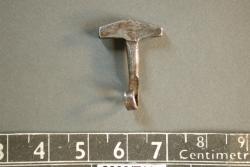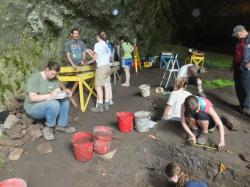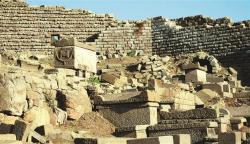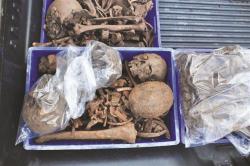INSTITUT SUPERIEUR D'ANTHROPOLOGIE
INSTITUTE OF ANTHROPOLOGY
ONLINE COURSES / COURS A DISTANCE
SUMMER TERM : JULY 2014
REGISTER NOW
DANEMARK –  Lolland - A runic inscription on an amulet found on the Danish island of Lolland confirms what we’ve all been waiting to know: those thousands of small hammer-shaped metal objects that matched the description of the legendary weapon from the Norse myths were in fact hammers. What tipped the specialists off was an inscription on one of the hammers that read “Hmar x is”, which rather straightforwardly translates as “This is a hammer”. This unknown craftsman – who was inexplicably literate – has done archaeologists a favour with his concise inscription and put the debate to rest. In Nordic mythology, Thor used his hammer to protect Asgard, the home of the Gods. It was said that the hammer was powerful enough to level mountains. Vikings commonly wore a small replica around their necks as a protective charm. “It was the amulet’s protective power that counted, and often we see torshammere and Christian crosses appearing together, providing double protection,” Peter Pentz, an archaeologist at the National Museum of Denmark, told Past Horizons.
Lolland - A runic inscription on an amulet found on the Danish island of Lolland confirms what we’ve all been waiting to know: those thousands of small hammer-shaped metal objects that matched the description of the legendary weapon from the Norse myths were in fact hammers. What tipped the specialists off was an inscription on one of the hammers that read “Hmar x is”, which rather straightforwardly translates as “This is a hammer”. This unknown craftsman – who was inexplicably literate – has done archaeologists a favour with his concise inscription and put the debate to rest. In Nordic mythology, Thor used his hammer to protect Asgard, the home of the Gods. It was said that the hammer was powerful enough to level mountains. Vikings commonly wore a small replica around their necks as a protective charm. “It was the amulet’s protective power that counted, and often we see torshammere and Christian crosses appearing together, providing double protection,” Peter Pentz, an archaeologist at the National Museum of Denmark, told Past Horizons.
http://cphpost.dk/news/1-100-year-old-amulet-confirms-hammer-of-thor-theory.10088.html?
USA –  Smallin Cave - Smallin Cave was the site of a recent three-week “field school in archaeology” class taught by Jack Ray, research archaeologist for the Center for Archaeological Research at Missouri State University. The excavation is the largest controlled dig ever controlled dig ever done at the cave. “Based on what we found, the artifacts date from about 7,000 years old to as young as about 700 years old,” Ray said. “This says that Smallin Cave was occupied intermittently over a period from at least 7,500 to 8,000 years ago off and on.” Many of the artifacts found are from the middle woodland period — about 2,000 years ago — which would indicate the most intensively occupied time, he said.However, cave owner Kevin Bright found a spear point in a stream bed that pushed the date back to about 8,200 years.
Smallin Cave - Smallin Cave was the site of a recent three-week “field school in archaeology” class taught by Jack Ray, research archaeologist for the Center for Archaeological Research at Missouri State University. The excavation is the largest controlled dig ever controlled dig ever done at the cave. “Based on what we found, the artifacts date from about 7,000 years old to as young as about 700 years old,” Ray said. “This says that Smallin Cave was occupied intermittently over a period from at least 7,500 to 8,000 years ago off and on.” Many of the artifacts found are from the middle woodland period — about 2,000 years ago — which would indicate the most intensively occupied time, he said.However, cave owner Kevin Bright found a spear point in a stream bed that pushed the date back to about 8,200 years.
http://www.news-leader.com/story/news/local/ozarks/2014/07/02/big-dig-smallin-cave/11639371/
MONGOLIE –  Gobi - Archaeologists from the University of Wrocław will conduct excavations in the Gobi Desert in Mongolia. The expedition is a part of the research project whose aim is to compare the adaptation of prehistoric societies to life in the desert. Prof. Józef Szykulski from the Institute of Archaeology of the University of Wrocław emphasised in an interview with PAP that work on the preparation for the research project is already well underway. "It has to be a global undertaking. In addition to the Gobi Desert, where our institution will begin research for the first time, we will also work on materials obtained from the southern Sahara (Sudan) and the Atacama and Nazca Desert in Peru" - said Prof. Szykulski. Wroclaw archaeologists have been conducting research in Peru and Sudan for many years. In the case of Sudan, the main organizer of the research is the Archaeological Museum in Gdańsk. The aim of the interdisciplinary research project (planned for four years) is a comparison of the adaptation of prehistoric societies to life in the desert. "It's even more interesting that all these deserts have different climatic conditions. We want to determine how in the prehistoric period, the time of hunter-gatherers and the first agricultural communities, these communities adapted to the desert conditions" - said the scientist.
Gobi - Archaeologists from the University of Wrocław will conduct excavations in the Gobi Desert in Mongolia. The expedition is a part of the research project whose aim is to compare the adaptation of prehistoric societies to life in the desert. Prof. Józef Szykulski from the Institute of Archaeology of the University of Wrocław emphasised in an interview with PAP that work on the preparation for the research project is already well underway. "It has to be a global undertaking. In addition to the Gobi Desert, where our institution will begin research for the first time, we will also work on materials obtained from the southern Sahara (Sudan) and the Atacama and Nazca Desert in Peru" - said Prof. Szykulski. Wroclaw archaeologists have been conducting research in Peru and Sudan for many years. In the case of Sudan, the main organizer of the research is the Archaeological Museum in Gdańsk. The aim of the interdisciplinary research project (planned for four years) is a comparison of the adaptation of prehistoric societies to life in the desert. "It's even more interesting that all these deserts have different climatic conditions. We want to determine how in the prehistoric period, the time of hunter-gatherers and the first agricultural communities, these communities adapted to the desert conditions" - said the scientist.
http://www.naukawpolsce.pap.pl/en/news/news,400996,wroclaw-archaeologists-will-conduct-research-in-the-gobi-desert.html
TURQUIE –  Assos - The ‘meat-eater’ tombs of the ancient city of Assos in Turkey’s northwest acquired fame throughout the world as bodies inside the tombs used to decompose within a short period of time. Forget about lions, tigers or other big predators, the real carnivores in Assos in Çanakkale are the ancient city’s tombs, whose stones are famous for causing bodies to decompose in record time. “The tombs here are first cut roughly, and their interior is carved. We know that the decorations on the tombs were made in the graveyard. Some long-time researchers have been trying to find out if the bodies decomposed in the tombs because of the stone used. Some researchers claim that the tombs include lots of aluminum material, and that that causes decomposition. Maybe the locals of Assos found that aluminum burned the skin and put this material inside the tombs for the body to decompose within a short time. In this way, the tombs of Assos have become famous around the world,” said Çanakkale 18 Mart University (ÇOMÜ) Archaeology Department Professor Nurettin Aslan, who is the head of the excavations in the ancient city. Aslan said the word “tomb” first appeared in Assos and was used as a concept to explain the stones in the city. The professor also said the Roman writer Plinius, in his a 37-volume work titled “History of Nature,” talked about the type of stone used in the Assos tombs. “He says the bodies that are put inside the tombs, which are made of this stone, completely decompose in 40 days. We know that other ancient resources mention the fame of this type of stone. Thanks to these resources, we found out that magnificent tombs were made of this stone,” he said. Arslan also said the empty tombs were sent to other countries. “The fact that these tombs are in different countries show that they were very expensive tombs. We can say that the Assos tombs were particularly preferred by people who read Plinius. The tombs are generally two meters long and 80-to-90 centimeters wide. It is possible to see wider and longer tombs in Assos, too. Their weight is about three tons. The most important feature of tombs is that their material is andesite stone and they are decorated. They are unique to Assos only. For example, all tombs in Rome have three wreathes in their long side. It is two in the ones made in Assos.” Examples of the special tombs still exist in stone pits on the north side of Assos, the professor said.
Assos - The ‘meat-eater’ tombs of the ancient city of Assos in Turkey’s northwest acquired fame throughout the world as bodies inside the tombs used to decompose within a short period of time. Forget about lions, tigers or other big predators, the real carnivores in Assos in Çanakkale are the ancient city’s tombs, whose stones are famous for causing bodies to decompose in record time. “The tombs here are first cut roughly, and their interior is carved. We know that the decorations on the tombs were made in the graveyard. Some long-time researchers have been trying to find out if the bodies decomposed in the tombs because of the stone used. Some researchers claim that the tombs include lots of aluminum material, and that that causes decomposition. Maybe the locals of Assos found that aluminum burned the skin and put this material inside the tombs for the body to decompose within a short time. In this way, the tombs of Assos have become famous around the world,” said Çanakkale 18 Mart University (ÇOMÜ) Archaeology Department Professor Nurettin Aslan, who is the head of the excavations in the ancient city. Aslan said the word “tomb” first appeared in Assos and was used as a concept to explain the stones in the city. The professor also said the Roman writer Plinius, in his a 37-volume work titled “History of Nature,” talked about the type of stone used in the Assos tombs. “He says the bodies that are put inside the tombs, which are made of this stone, completely decompose in 40 days. We know that other ancient resources mention the fame of this type of stone. Thanks to these resources, we found out that magnificent tombs were made of this stone,” he said. Arslan also said the empty tombs were sent to other countries. “The fact that these tombs are in different countries show that they were very expensive tombs. We can say that the Assos tombs were particularly preferred by people who read Plinius. The tombs are generally two meters long and 80-to-90 centimeters wide. It is possible to see wider and longer tombs in Assos, too. Their weight is about three tons. The most important feature of tombs is that their material is andesite stone and they are decorated. They are unique to Assos only. For example, all tombs in Rome have three wreathes in their long side. It is two in the ones made in Assos.” Examples of the special tombs still exist in stone pits on the north side of Assos, the professor said.
http://www.hurriyetdailynews.com/meat-eater-tombs-in-assos-display-taste-for-flesh.aspx?PageID=238&NID=68473&NewsCatID=375
USA – Lake George - Professor David Starbuck and his archaeology crew of volunteers and SUNY Adirondack students have not explored Lake George Battlefield Park in 13 years. He’s ready to go back, and he starts Monday. “The battlefield park played host to some huge events. The (Department of Environmental Conservation) wants to more comprehensively understand what is in the park,” he said, noting it was important in both the French and Indian War and the Revolutionary War. “There were troops moving in and out of here for 20 to 25 years, and no one has established exactly where all of the events took place.” Battlefield Park was the setting for the Battle of Lake George, an entrenched camp of reinforcements for Fort William Henry at the time of the massacre in 1757, the main camp of British armies of 8,000 to 10,000 in 1758 and 1759 and a major camp during the early part of the Revolutionary War. Although never completed, the plan was for Fort George, which is on the battlefield site, to become the largest British fort in the American colonies. “We’re talking about the biggest British armies in the colonies in 1858 and 1859. This has enabled the students at SUNY Adirondack to do more work on sites from the French and Indian War than any other school in the Northeast,” said Starbuck, whose two previous digs there focused on the remains of huts and barracks, as well as the one remaining bastion of the fort (Fort George).”
http://poststar.com/news/local/summer-archaeological-dig-to-shift-to-lake-george-battlefield/article_a0b7add8-009f-11e4-b182-001a4bcf887a.html
TURQUIE –  Milas - A Roman tomb has been discovered during infrastructure works carried out by a private company in the western province of Muğla. Six skeletons, 13 bottles, a couple of earrings and a mirror were found inside the tomb. The skeletons are estimated to belong to the members of the same family. Speaking to press members, Milas district governor Fuat Gürel said many historical artifacts had been discovered during the process, adding, “Museum officials found the tomb when they examined the area. Archaeologists have taken the pieces to the Milas Archaeology Museum, where they will be preserved.” Infrastructure construction engineer Gökhan Güneş said they had stopped their progress when the Caterpillar construction vehicle came upon a hard object. “We saw that it was the cover of a tomb. Museum officials came to the area and started working. They found objects like skeletons, bottles, mirrors and jewelry inside the tomb. This is very exciting for us,” he said.
Milas - A Roman tomb has been discovered during infrastructure works carried out by a private company in the western province of Muğla. Six skeletons, 13 bottles, a couple of earrings and a mirror were found inside the tomb. The skeletons are estimated to belong to the members of the same family. Speaking to press members, Milas district governor Fuat Gürel said many historical artifacts had been discovered during the process, adding, “Museum officials found the tomb when they examined the area. Archaeologists have taken the pieces to the Milas Archaeology Museum, where they will be preserved.” Infrastructure construction engineer Gökhan Güneş said they had stopped their progress when the Caterpillar construction vehicle came upon a hard object. “We saw that it was the cover of a tomb. Museum officials came to the area and started working. They found objects like skeletons, bottles, mirrors and jewelry inside the tomb. This is very exciting for us,” he said.
http://www.hurriyetdailynews.com/skeletons-found-in-roman-tomb-.aspx?pageID=238&nID=68550&NewsCatID=375